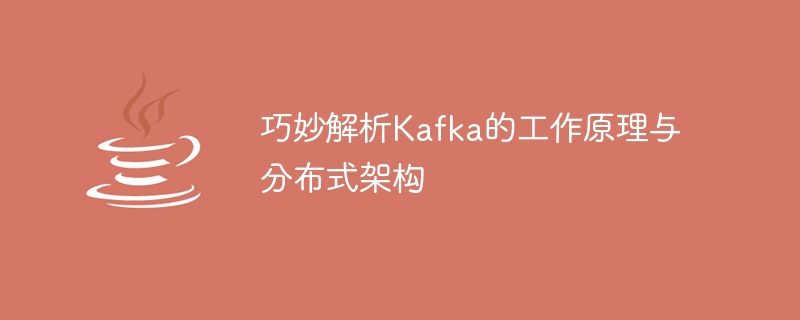 Java
Java
 javaTutorial
javaTutorial
 In-depth exploration of Kafka's distributed architecture and operating principles
In-depth exploration of Kafka's distributed architecture and operating principles
In-depth exploration of Kafka's distributed architecture and operating principles

Kafka工作原理
Kafka是一个分布式流处理平台,它允许您以可扩展和容错的方式构建和运行流处理应用程序。Kafka的主要组件包括:
- 生产者(Producer):将数据发送到Kafka集群的客户端。
- 代理(Broker):存储和管理Kafka数据的分散式服务器。
- 消费者(Consumer):从Kafka集群读取数据的客户端。
Kafka使用一种称为“主题”(Topic)的数据结构来组织数据。主题是一个逻辑上的数据分区,可以容纳来自多个生产者的数据。消费者可以订阅主题,并从主题中读取数据。
Kafka还使用一种称为“分区”(Partition)的概念来实现数据并行化。每个主题都分为多个分区,每个分区都是一个独立的存储单元。这允许Kafka在多个代理上存储和处理数据,从而提高吞吐量和容错性。
分布式架构
Kafka是一个分布式系统,这意味着它可以在多个服务器上运行。这使得Kafka具有很强的可扩展性和容错性。如果一台服务器出现故障,Kafka可以自动将数据复制到其他服务器上,从而保证数据的安全性和可用性。
Kafka的分布式架构还允许您在多个数据中心之间复制数据。这可以提高数据的可用性和可靠性,并允许您在不同的地理位置访问数据。
代码示例
以下是一个简单的Java程序,演示如何使用Kafka发送和接收数据:
import org.apache.kafka.clients.producer.KafkaProducer;
import org.apache.kafka.clients.producer.ProducerRecord;
import java.util.Properties;
public class KafkaProducerExample {
public static void main(String[] args) {
// Create a Kafka producer
Properties props = new Properties();
props.put("bootstrap.servers", "localhost:9092");
props.put("key.serializer", "org.apache.kafka.common.serialization.StringSerializer");
props.put("value.serializer", "org.apache.kafka.common.serialization.StringSerializer");
KafkaProducer<String, String> producer = new KafkaProducer<>(props);
// Create a Kafka record
ProducerRecord<String, String> record = new ProducerRecord<>("my-topic", "hello, world");
// Send the record to Kafka
producer.send(record);
// Close the producer
producer.close();
}
}以下是一个简单的Java程序,演示如何使用Kafka接收数据:
import org.apache.kafka.clients.consumer.ConsumerConfig;
import org.apache.kafka.clients.consumer.ConsumerRecord;
import org.apache.kafka.clients.consumer.ConsumerRecords;
import org.apache.kafka.clients.consumer.KafkaConsumer;
import java.util.Collections;
import java.util.Properties;
public class KafkaConsumerExample {
public static void main(String[] args) {
// Create a Kafka consumer
Properties props = new Properties();
props.put(ConsumerConfig.BOOTSTRAP_SERVERS_CONFIG, "localhost:9092");
props.put(ConsumerConfig.GROUP_ID_CONFIG, "my-group");
props.put(ConsumerConfig.KEY_DESERIALIZER_CLASS_CONFIG, "org.apache.kafka.common.serialization.StringDeserializer");
props.put(ConsumerConfig.VALUE_DESERIALIZER_CLASS_CONFIG, "org.apache.kafka.common.serialization.StringDeserializer");
KafkaConsumer<String, String> consumer = new KafkaConsumer<>(props);
// Subscribe to a Kafka topic
consumer.subscribe(Collections.singletonList("my-topic"));
// Poll for new records
while (true) {
ConsumerRecords<String, String> records = consumer.poll(100);
for (ConsumerRecord<String, String> record : records) {
System.out.println(record.key() + ": " + record.value());
}
}
// Close the consumer
consumer.close();
}
}总结
Kafka是一个功能强大、可扩展且容错的流处理平台。它非常适合构建实时数据处理应用程序。Kafka的分布式架构使其能够处理大量数据,并保证数据的安全性和可用性。
The above is the detailed content of In-depth exploration of Kafka's distributed architecture and operating principles. For more information, please follow other related articles on the PHP Chinese website!

Hot AI Tools

Undresser.AI Undress
AI-powered app for creating realistic nude photos

AI Clothes Remover
Online AI tool for removing clothes from photos.

Undress AI Tool
Undress images for free

Clothoff.io
AI clothes remover

AI Hentai Generator
Generate AI Hentai for free.

Hot Article

Hot Tools

Notepad++7.3.1
Easy-to-use and free code editor

SublimeText3 Chinese version
Chinese version, very easy to use

Zend Studio 13.0.1
Powerful PHP integrated development environment

Dreamweaver CS6
Visual web development tools

SublimeText3 Mac version
God-level code editing software (SublimeText3)

Hot Topics
 1382
1382
 52
52
 How to modify Douyin IP location
May 04, 2024 pm 04:36 PM
How to modify Douyin IP location
May 04, 2024 pm 04:36 PM
Yes, you can modify the Douyin IP location as follows: Open Douyin and edit your profile. Modify the city information and select the city or region you want to display. Log out and log back in for the changes to take effect.
 Does Amap require mobile phone registration?
May 05, 2024 pm 05:12 PM
Does Amap require mobile phone registration?
May 05, 2024 pm 05:12 PM
Yes, for security, personalized services and account management, Amap requires registration with a mobile phone number. The registration steps include: Open the Amap app, click "My" and "Login/Register", select a mobile phone number to register, enter the mobile phone number to get the verification code, set a password to complete the registration.
 How to post pictures and videos on Weibo
May 03, 2024 am 01:15 AM
How to post pictures and videos on Weibo
May 03, 2024 am 01:15 AM
The steps for posting pictures and videos at the same time on Weibo are as follows: Select related or complementary pictures and videos. Open the Weibo client and click the Publish button. Select the "Pictures & Videos" tab. Add pictures and videos (up to 9 pictures and 1 video). Enter text and add relevant information. Just publish it.
 How to reset Douyin recommendations? How to change recommendation to featured?
May 08, 2024 pm 03:52 PM
How to reset Douyin recommendations? How to change recommendation to featured?
May 08, 2024 pm 03:52 PM
As a social platform focusing on short videos, Douyin’s recommendation algorithm is one of its core functions. It can recommend relevant video content based on users' interests and behaviors. Sometimes users may want to reset the recommendation algorithm to get content more in line with their preferences. So, how to reset Douyin recommendations? How to change Douyin recommendation to featured? This article will answer both questions for you. 1. How to reset Douyin recommendations? 1. Open Douyin APP and enter your personal homepage. 2. Click the "Settings" icon in the upper right corner to enter the settings page. 3. On the settings page, find the "Recommended Management" option and click to enter. 4. On the recommendation management page, you can see your interest tags and interest preferences. You can select or deselect different
 How to change recommendation settings on TikTok
May 04, 2024 am 12:06 AM
How to change recommendation settings on TikTok
May 04, 2024 am 12:06 AM
Douyin recommendations can be changed by changing the "Content Preferences" settings, including adjusting recommended video types, following interested creators, blocking disliked content, setting video language, geographical location restrictions, following hot topics and clearing search/browsing history .
 How to modify location permissions on TikTok
May 03, 2024 pm 11:24 PM
How to modify location permissions on TikTok
May 03, 2024 pm 11:24 PM
Steps to modify Douyin location permissions: 1. Open the Douyin app and click "Me". 2. Click the "three horizontal bars icon" in the upper right corner. 3. Select Settings. 4. Find "Privacy Settings" and click on it. 5. Click "Location Services". 6. Select Allow targeting or Only ask when using, as appropriate. 7. After modification, you need to restart the Douyin application to take effect.
 How to change TikTok time zone settings
May 04, 2024 am 01:57 AM
How to change TikTok time zone settings
May 04, 2024 am 01:57 AM
Douyin time zone settings cannot be changed, the time zone will be automatically set based on the current geographical location.
 Introduction to how to turn off photo watermarks on Honor phones
May 08, 2024 pm 01:20 PM
Introduction to how to turn off photo watermarks on Honor phones
May 08, 2024 pm 01:20 PM
1. First, we open the camera and click the settings icon in the upper right corner. 2. Turn off the geolocation and automatic watermark switches.



